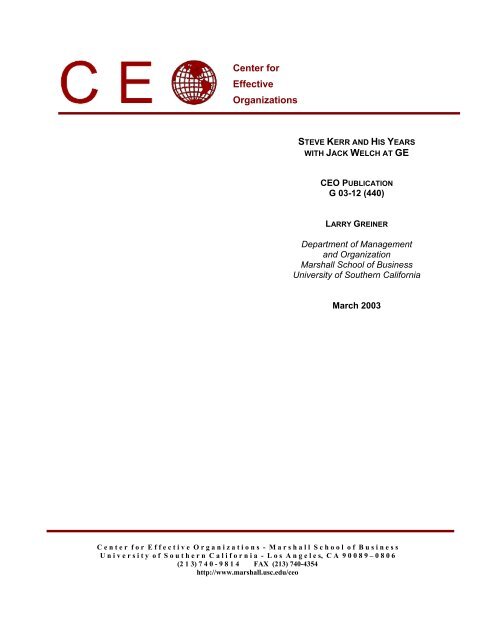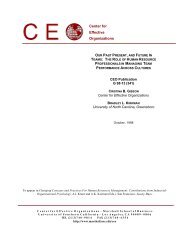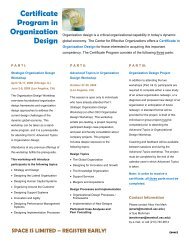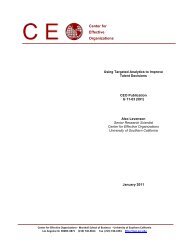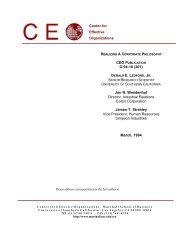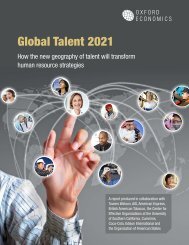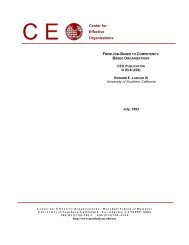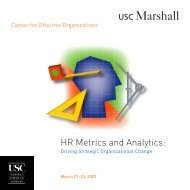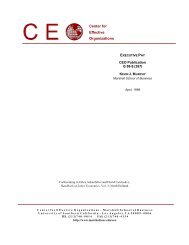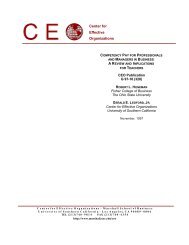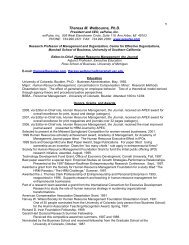Center for Effective Organizations - University of Southern California
Center for Effective Organizations - University of Southern California
Center for Effective Organizations - University of Southern California
You also want an ePaper? Increase the reach of your titles
YUMPU automatically turns print PDFs into web optimized ePapers that Google loves.
Steven Kerr BioSteve Kerr and His Years with Jack Welch at GEbyLarry GreinerPr<strong>of</strong>essor <strong>of</strong> Management and OrganizationMarshall Business School<strong>University</strong> <strong>of</strong> <strong>Southern</strong> Cali<strong>for</strong>niaSteve Kerr is Chief Learning Officer and a Managing Director <strong>of</strong> Goldman Sachs. Until March<strong>of</strong> 2001 he was vice president <strong>of</strong> leadership development and chief learning <strong>of</strong>ficer <strong>for</strong> GeneralElectric, including responsibility <strong>for</strong> GE’s renowned leadership education center at Crotonville.He was <strong>for</strong>merly on the faculties <strong>of</strong> Ohio State <strong>University</strong>, the <strong>University</strong> <strong>of</strong> <strong>Southern</strong> Cali<strong>for</strong>niaand the <strong>University</strong> <strong>of</strong> Michigan, and was dean <strong>of</strong> the faculty <strong>of</strong> the USC business school from1985-1989. Dr. Kerr is a past-president <strong>of</strong> the Academy <strong>of</strong> Management. His writings onleadership and “on the folly <strong>of</strong> rewarding A, while hoping <strong>for</strong> B” are among the most cited andreprinted in the management sciences. During the last few years he has been the subject <strong>of</strong>interviews in Business Week, Forbes ASAP, Fortune, Human Resource Executive, Intranet,Investors Business Daily, The New York Times, Organizational Dynamics, KnowledgeManagement, Organization Science, and The Wall Street Journal.Author’s IntroductionThis interview with Steve Kerr is about two intriguing phenomena at GE—the obvious one isJack Welch’s leadership role, and the less obvious, while not intended by him, is Steve’s role inthe background acting as Welch’s skillful consultant <strong>for</strong> 11 years.In 1994, many people in academe were surprised and perplexed when Steve Kerr left the com<strong>for</strong>t<strong>of</strong> tenure and scholarly fame <strong>for</strong> a full-time job at General Electric. But if you know Steve itmay not have been such a surprise. He is a person who is always moving on, from Ohio State toU.S.C. to Michigan to GE, and now to Goldman Sachs.No doubt Steve likes power and hefty rewards (“who doesn’t?”), but that isn’t what comesthrough in this interview. It is a story <strong>of</strong> his intense desire to explore and learn from a newsituation and to play a key role in determining what is likely the “corporate success story” <strong>of</strong> thecentury.Most academics never get close to the likes <strong>of</strong> Jack Welch, let alone to act as their consultants.In doing so, Steve gives us his insights about the many ways in which Welch (and other leadersthere) moved the company <strong>for</strong>ward; it is a glimpse that would never emerge from a dry empiricalstudy with a large sample size, or even from Welch’s recent bestseller, “Straight from the Gut.”
It is also clear that Steve Kerr contributed significantly to GE’s trans<strong>for</strong>mation, although he doesnot take much credit. We are delighted that he still maintains his strong roots and contacts inacademe. And this interview is one example.Interview with Steve KerrGreiner: Steve, I will always remember you at U.S.C. as a strong researcher who loved academeand liked to write good journal articles. You were also President <strong>of</strong> the Academy. Yet you leftacademe <strong>for</strong> GE. Why? What was the transition like?Kerr: I’ll tell you, it was gradual. I got asked by GE to commit to 25 days a year in 1989 toconsult as a facilitator <strong>for</strong> its emerging Workout program. It was <strong>for</strong> 2 days a month, which Ifigured was about my only free time. I was an administrator, as well as a pr<strong>of</strong>essor at U.S.C. Iloved U.S.C.Greiner: But you got more involved at GE?Kerr: I got lucky. The best job in the world is an easy job disguised as a hard job. They put meinto their Nuclear company <strong>for</strong> Workout. I was the only pr<strong>of</strong>essor from the West who waschosen, since Nuclear was the only GE business headquarters there. GE thought Workout wouldgo poorly in Nuclear because it was one <strong>of</strong> most regulated businesses at GE. But it went well,and I ended up looking good. So they gave me more and more businesses to consult to withinGE.Greiner: Was it all Workout, or were you getting into other activities?Kerr: It was mainly Workout, although there were some <strong>of</strong>fshoots, like I did some trainingsessions on dealing with difficult people. GE wanted more and more days from me, and so in1991 I went on leave from U.S.C. By 1992, I was working 210 days <strong>for</strong> GE. Also, in 1992, I<strong>for</strong>mally left U.S.C. and joined the Michigan faculty. That was because it was in the right timezone, and they were more flexible than U.S.C. I wanted to stay with U.S.C. but it wasn’tpossible.Greiner: Had you met Jack Welch during this time?Kerr: I was one <strong>of</strong> the many people meeting him in the spring <strong>of</strong> 1989, and by about 1990 or ’91,he was using me as his outside consultant--basically, <strong>for</strong> four years, all beginning with Workout,which was a key program <strong>of</strong> his. Along the way, I turned down a couple <strong>of</strong> <strong>of</strong>fers to go inside,and then in March <strong>of</strong> 1994, I took the inside job as the head <strong>of</strong> their main training facility atCrotonville, New York.Greiner: So Welch made you an <strong>of</strong>fer you couldn’t refuse?Kerr: Welch used me as his “poster-boy” <strong>for</strong> Workout in the beginning <strong>of</strong> 1990. He wanted toget some <strong>of</strong> their businesses moving faster, and he put me put me there and we got some goodresults. So the message from Welch to his senior executives was, “Look at this, Kerr’s doing it in
Nuclear, so why the hell aren’t you?” Then some <strong>of</strong> them fired their Workout consultants, andthey asked me to take on another business, then they asked me to take on a third business. I hada stand-up role…I was a facilitator. It wasn’t too dissimilar in the beginning from what mostacademics do. The transition wasn’t abrupt; it was just, as I say, by inches.Greiner: What was your title and responsibility at GE?Kerr: My title was Vice-President, Leadership Development based at Crotonville. Then a monthafter I started, I did a Workout session with some top people, and people there suggested I dosome new things, and said I ought to be the Chief Education Officer. So, I went to Welch andsaid, “I’m going to be a CEO just like you.” And he laughingly said, “There’s only one <strong>of</strong> thoseat GE!” Then he said, “You can be Chief Learning Officer.” So I had that title, but it was notwhy I took the job, and when I had the title no one knew what it was, including me. I had thetitle and then I had to devise a job description.Greiner: Were you reporting to Welch?Kerr: Welch was the one who courted me. The Crotonville facility rolls-up to HR. So, in thatsense, it reported to the top HR <strong>of</strong>ficer. But I always reported to Welch. From the beginning hecalled me and gave me direct orders… we would meet and have lunch once in a while, notfrequently, but regularly. My replacement reports to HR now, and that was the way it probablywould have happened <strong>for</strong> me as well. But because I always worked <strong>for</strong> Jack <strong>for</strong> years be<strong>for</strong>e, hejust kept calling me and I just kept responding. Plus at Crotonville, leaders <strong>of</strong> the corporationtaught 60% <strong>of</strong> the senior level courses, and Jack was <strong>of</strong>ten there in front <strong>of</strong> a group. I worked <strong>for</strong>Jack, and Jack “worked <strong>for</strong> me”. So it just kind <strong>of</strong> stayed that way; we didn’t do it <strong>for</strong>mally.Greiner: What did you do as the Chief Learning Officer?Kerr: Well, it was funny--the New York Times put my picture in the paper, and they said nowGE has both a CIO (Chief In<strong>for</strong>mation Officer) and now a CLO (Chief Learning <strong>of</strong>ficer)…it wasmy 15 minutes <strong>of</strong> fame. Then I had to figure it out. The job <strong>of</strong> the CIO, and we had a very goodone at GE, was to improve peoples’ ability to move in<strong>for</strong>mation across boundaries. CIO’s worryabout hardware and s<strong>of</strong>tware incompatibilities, protecting data on the internet, bandwidth, thatstuff. I said, “You know, what people are not worrying about is the motivation to communicateacross boundaries.” In my view, the most important reason why people don’t communicate anddon’t share in<strong>for</strong>mation is because they don’t want to. That’s not something the CIO typicallyworries about. So my job became to identify the barriers. What is it about the way we organizework and build rewards? What is it that keeps people from wanting to communicate, and whatadjustments in rewards, and norms, and so on, would create more motivation? That was thedivision <strong>of</strong> labor…the CIO worked on ability to communicate, and the CLO worked on desire tocommunicate.Greiner: What kind <strong>of</strong> programs were you doing to spread knowledge practices around? Iremember you gave a talk at U.S.C a couple <strong>of</strong> years ago, something about your becoming a“911” person?
Kerr: You have to give people a “911” if you want to increase learning in a company. They needa number to call, places to go to share good ideas, or if they want to search <strong>for</strong> something outthere. For example, if you’re at U.S.C. and you want to find out if there is any part <strong>of</strong> U.S.C.that’s really good at managing alumni relations, or good at fund-raising, or good at recruitingminority students? At USC you could ask, but you wouldn’t know who to go to, because there’sno one place you could find out. If Biology did it well, Math would never know it. So, acorporation is the same way. I used the term “911” because the “911” guy never comes to yourhouse directly. He brokers supply and demand. Somebody calls and says, “I have a fire.” The“911” guy sends the fire department. So that’s why I used that metaphor…that’s the job <strong>of</strong> theCLO. Sometimes you have people saying, “I need to know, is there anybody out there who doesa good job on educating about quality?”Greiner: You were looking around inside and outside GE <strong>for</strong> best practices and thencommunicating them across the company. How did you do that?Kerr: We’d occasionally do best-practices conferences at Crotonville, and I was able to locategood ideas from the outside because I was an academic. Remember, be<strong>for</strong>e me in my job atCrotonville was Jim Baughman from Harvard who came up with the idea <strong>for</strong> Workout inconversations with Welch; and be<strong>for</strong>e him was Noel Tichy from Michigan. I think Jack wantedan academic in my job because we were plugged in not only to what other corporations weredoing, but also through the Academy <strong>of</strong> Management and the OD Network. So, <strong>for</strong> example, Iknew when re-engineering got started, and I knew when mass-customization got started.Greiner: It seems Crotonville, and your leadership <strong>of</strong> it, was playing an important role inhelping Welch bring about change at GE. Tell me more about Crotonville and the role you and itplayed.Kerr: Not counting the road shows where we went out into the company, we had five to sixthousand GE managers and executives coming through per year, and if you add customers, itwent up by a couple thousand more. There was also a third group, the divisions, which wouldsometimes just rent the room, so to speak. So if you counted them all, the total number goingthrough Crotonville per year had to go over 10,000.Greiner: Was there a key program that Welch focused on…where he came to Crotonville andspent some time with a group?Kerr: There were three programs that were the executive series. The first was given seven timesa year and it had about 65 people each time. They were high potential middle managers thattypically had 8 to 10 years in the company. That one received a big focus by Welch and theother senior leaders. It was a four-week course, which later we cut to three weeks, and almost allthe faculty were insiders. Welch, <strong>for</strong> example, taught a four-hour class to each <strong>of</strong> those, so seventimes a year he taught a class called “leadership and values.” The Vice-Chairman taught, theCFO taught, etc. The next course called “Business Management” was taught three times a year,and that had a big action-component, so there wasn’t much classroom time, but Welch and othersalways taught in that one. The final course, taught once a year, was the executive course. Wealso ran that one, and there were <strong>of</strong>ten a half-dozen corporate <strong>of</strong>ficers as participants in each
course, or likely future <strong>of</strong>ficers. So those three courses got senior level attention. The top two <strong>of</strong>those involved action-projects to present their implications to Welch and the CorporateExecutive Council…we had two hours with Welch and others to listen. These programs hadhuge focus, and major decisions were taken as a result …we were not just patronizing thestudents. Huge decisions were made from these sessions.Greiner: So Welch and other senior level people would sit in and listen to the presentations and<strong>of</strong>ten act on the recommendations?Kerr: There would be presentations by the class to Welch and the top 30 people…one example;members <strong>of</strong> the class went to South America to benchmark us against competition. They cameback and said, “We are all talk and no action. ABB is there, Siemens is there, and we’re notthere. We should either get in or get out.” As a result, GE created a South American operation,put an <strong>of</strong>ficer as the CEO <strong>for</strong> South America and built big results.Greiner: So when you say, “big decisions were made”, were the participants asked to study theseissues be<strong>for</strong>ehand or were they meeting on them while at Crotonville?Kerr: They got a topic be<strong>for</strong>e they came. Then they got a few days at Crotonville to begin workon the issue. For example, the topics ranged from, “Should we use Russia <strong>for</strong> manufacturing, orsourcing?” Or, “Should we double our investment in India?” Other times it was based on atechnology, “Should we penetrate a certain market?” Other times the topic would be a generalone, “How do we get better at Six-Sigma? How do we get better at e-business?” So after a fewdays <strong>of</strong> what they needed to know, the class would go <strong>of</strong>f, usually in pairs. Collectively theywould conduct more than 200 interviews, and we had people whose full-time job was just to setup these classes every year. The Indian group met Mother Theresa one time. Others met heads<strong>of</strong> state; they met heads <strong>of</strong> unions; they met heads <strong>of</strong> corporations. GE’s presence, and the factthat GE might invest were sufficiently powerful, so <strong>of</strong>ten you’d get a very high-level <strong>of</strong>interviews. They would go <strong>of</strong>f, they would ask questions, and then they would come back toCrotonville, spend a few days triangulating their data and preparing their briefing, and then theywould present, as I mentioned, to the top 30 people. Another example <strong>of</strong> a big decision waswhen one <strong>of</strong> the classes identified a gap in the value chain <strong>of</strong> one <strong>of</strong> our businesses. GE thenwent out and bought a very expensive, big company to fill the gap.Greiner: Were decisions there handled on the spot like in Workout sessions? Or would thesenior people go back and think about what they heard?Kerr: No, there were no ground rules. Sometimes it was the senior people going back to thinkabout it, but other times it was immediately reacted to, especially if Jack loved the idea.Greiner: You could see Welch react right there?Kerr: Sure, one class came back and told Jack that his favorite mantra <strong>of</strong> “first or second inmarket share, or fix, sell, or close” was now dysfunctional. They said, “Jack, it might have beenright when you put it in, but now the closer you get to 100%, the lower the up-side potential.”They proposed to Jack, and he implemented it, that all his strategy meetings he should have
people answer the question: “Imagine your market share is less than 5%. Describe yourmarket?” So, <strong>for</strong> example, at NBC, their management said in answer to that question, “Well,every time somebody turns on a box <strong>for</strong> in<strong>for</strong>mation or entertainment, that’s our competitor….there<strong>for</strong>e, Nintendo is a competitor”. These insights took many <strong>of</strong> our companies in newdirections.Greiner: What was your role in these sessions—did you lead them or sit in?Kerr: I sat in on all <strong>of</strong> them, and usually I would have a module. I would teach a little bit, just asone <strong>of</strong> the faculty. We had people who would work with the class on presentation skills, gettingit together, sometimes if it was on a topic where I could be helpful I would hang around morethan others. Sometimes I just went because it was fun to be there. Like I went with a group toRussia, because I had never been to Russia. But I wasn’t essential. We had a staff, and a lot <strong>of</strong>peer learning. They were always getting good ideas from benchmarking..Greiner: How did Crotonville evolve while you were there?Kerr: I globalized it, but I don’t mean to take credit. Anybody in my job in 1994 would havehad to make that change. GE was moving from a US company to getting large numbers <strong>of</strong>employees and revenue from overseas. When I got there, there were two people outside the USwho were working <strong>for</strong> Crotonville. By the time I left, we had a Crotonville-Europe located inBrussels and a Crotonville – Asia. I had people on the ground in Singapore, Beijing, Hong Kong,New Delhi, and especially Tokyo. And then I had a small operation based in Mexico City toservice Mexico and Latin America. The other major change that I introduced was getting intothe business <strong>of</strong> client education. This had been done be<strong>for</strong>e, but it was only a small part <strong>of</strong> thebusiness. By the time I left we had, on the average, four outsiders a day requesting permission tocome to Crotonville to visit us, or to benchmark us, or study from us.Greiner: What was your relationship with Welch like during all <strong>of</strong> this? Did you go and talk tohim or suggest things to him, or would he ask you?Kerr: I always had his ear. He was at Crotonville about twice a month, and I was in Fairfield(corporate headquarters) occasionally. I was a member <strong>of</strong> the corporate council, and I was amember <strong>of</strong> the corporate staff. So, we were around a lot together. I always had his ear…I mean,I won some, and I lost some. Sometimes I had ideas that were taken seriously, and sometimes herefused to do what I wanted him to do. If I said, “This is a session you ought to kick <strong>of</strong>f,” hewould usually do it. But I knew how busy he was. I tried to protect his time. We were neverclose, but we were colleagues…we worked together <strong>for</strong> 11 years.Greiner: In the Harvard GE cases, we teach about the many waves <strong>of</strong> major change at GE, andhow Welch always seemed to be out front as the leader. There was the initial period <strong>of</strong> portfoliore-structuring, and then there was a phase <strong>of</strong> efficiency with Workout, and later globalization ande-business. Was Welch the leader <strong>of</strong> all these?Kerr: Looking back, I think the company got over-dependent on him. Charismatic leaders makeyou lazy. So, as big as GE is, senior managers <strong>of</strong>ten looked to Welch’s personal touch to signal
this or that was important. If you got Welch behind something that made it a corporate initiative--launching at Crotonville made it a corporate initiative. Now, Welch was not the originator <strong>of</strong>all the ideas. He hesitated on implementing 6-Sigma because he just felt it was not GE. In fact, Ibelieve we got into it because Welch had heart surgery and missed the Corporate ExecutiveCouncil meeting where the decision was made ….by coincidence, the speaker that day was LarryBossidy (CEO <strong>of</strong> Allied Signal and <strong>for</strong>mer GE senior executive) who had just gotten into Six-Sigma the year be<strong>for</strong>e and said we ought to do it. Bossidy said, “I know you guys, and if youdecide to do Six-Sigma, you’ll write the book on it.”, and he got everybody so excited that by thetime Welch came back even he couldn’t stop it… he just said we’ve got to try it. Once Jack goton board, he became the champion and the leader…but he didn’t come up with the idea. Thesame thing happened with e-business…a lot <strong>of</strong> the younger people were more interested in thecomputer and the internet than Jack, and, in fact, one <strong>of</strong> our businesses, medical systems, wasway ahead <strong>of</strong> Jack. But once Welch realized it’s importance, he got in front and made it hiscorporate initiative. Every once in a while he did find one. Demand-flow technology he broughtin because he was going out with customers and he became excited about it.Greiner: Did Six-Sigma make a big impact at GE?Kerr: Oh, yeah! It was very powerful, but it was a surprise <strong>for</strong> several reasons. It was put in tobe a statistical control and quality improvement technique. But the surprise was that it became afabulous leadership developmental experience. We put thousands through it and then with all theBlack Belts we were running people through rotating assignments and they became much betterleaders because <strong>of</strong> that experience. The second surprise is that we got on to the use <strong>of</strong> scorecards<strong>for</strong> the first time. It enabled GE to really look at the world through the eyes <strong>of</strong> their customers,and so it became a fabulous device <strong>for</strong> getting closer to the market.Greiner: Did Welch change much during this period <strong>of</strong> changing and introducing variousprograms? He was “Neutron Jack” at one point and then some have said he mellowed out later.Kerr: Yes, he changed. I wasn’t there in ’81, and I’ve heard Jack was difficult but that later hegot more thoughtful about how he did things. After his heart operation, he seemed “overoxygenated”!When you give an operation like that to a CEO, you ought to give the same one totheir immediate supporters. Welch became very fatiguing to be around, and I don’t know if hewas just physically stronger or had a sense <strong>of</strong> mortality with time passing. But I found hebecame more impatient, more demanding. He did it in a more acceptable way, so he was a betterleader than he had been in 1981.Sometimes I felt that he would make decisions without checkingwith the right people. He had a lot <strong>of</strong> faith in his own intuition, and I think in the area <strong>of</strong> HR, <strong>for</strong>example, he didn’t respect it enough. He wouldn’t do a deal without checking with the mergerteam. He wouldn’t sue or settle without checking with legal. But he had the feeling that largeparts <strong>of</strong> HR are basically common sense, so he would select the stock option plan, or the pay<strong>for</strong>mula <strong>for</strong> compensation, without getting in touch with what the existing research and theory inthat area, and I felt this was to his detriment.Greiner: But I’ve heard he spent a lot <strong>of</strong> time on people…in evaluating and rewarding them.
Kerr: Yes, absolutely. It wasn’t because he’s cuddly. Once in a meeting with some CEO’s, hesaid, “At the end <strong>of</strong> the day, I don’t know how to build a jet engine.” And he said, “I don’t knowwhat should go on Thursday night now that Seinfeld is <strong>of</strong>f the air.” He said, “I can’t know that,and I’ll never get that technical skill, so I have to trust the people.” So he says, “The problem isthat when people bring me stuff, they’ve got a good idea and they want more money than I have.They’re going to move the nozzle to get better noise control, or better fuel emission. You’ve gotto know who you’re talking to.” So Welch said, “I have to judge the people because I can’tjudge the technical merits.” All that part about him and people is true, but it doesn’t follow thathe was a great apostle <strong>of</strong> HR.Greiner: You recently left GE to go to Goldman-Sachs in a similar job? What got you to leaveGE? And why not go back to academe?Kerr: I kind <strong>of</strong> thought I would leave when Welch left. I met with an old mentor <strong>of</strong> mine a fewmonths be<strong>for</strong>e, who told me, “If you haven’t got it done in five years, why don’t you givesomebody else a chance?” I was on leave from Michigan, and I had intended to go back…I stilllove academe. But Goldman came to Crotonville to observe, and they fell in love with theapproach we used. So they were courting me <strong>for</strong> most <strong>of</strong> the year. I was flattered. I mean it’sthe premier investment bank on Wall Street. I just felt it was such a classy outfit. Then, I lost myMom, and my Dad’s living alone in lower Manhattan. One <strong>of</strong> the factors was that I’d be closer tomy Dad.Greiner: How do you find Goldman-Sachs now? How different is your role from the one at GE?Kerr: I didn’t know what I would find. I’d never worked on Wall Street. I had watched theMichael Douglas movies. You know, obviously if I thought the people were like that I wouldn’thave come. I can’t tell you what an honorable and classy outfit this place is. The integrity,they’ll walk away from money in a minute if it’s a wrong deal <strong>for</strong> the client. That’s not to sayGE wasn’t like that… Welch was always very rigorous about integrity. I’ve also found Goldmanto be very considerate <strong>of</strong> its employees…here’s just one example out <strong>of</strong> 10,000. I lost my homein the terrorist attack, and there were many other employees who were also dislocated. So an e-mail came out, saying, “On October 15 th there is going to be $1,000 extra per family member inyour pay envelope. Use it to buy clothing if you were affected by 9/11.” And then they said, “Ifyou have money left over, please donate it to the firemen/police relief fund.” No request <strong>for</strong>receipt, it was just so classy.Greiner: So you’ve been pleasantly surprised by the high ethics at Goldman?Kerr: Friends told me, “You’re selling your soul to Wall Street.” Nothing could be further fromthe truth. In terms <strong>of</strong> some <strong>of</strong> the stereotypes, it’s true. They’re the smartest people in the world,unlike GE, which tended to hire BAs from state schools. At Goldman, they hire summa cumlaude from places like Harvard and Stan<strong>for</strong>d. There is pride. I won’t call it arrogance, but thereis pride. They’re very good and they don’t have a lot <strong>of</strong> time to spend. This business is veryquick. So it’s kind <strong>of</strong>, “I’m smart, talk faster…. I’m smart, gotta go now.” GE gave me fourweeks to design a class, and then they said to cut it down to three weeks. In contrast, Goldmansays, “I’ll give you two days, but please don’t take the whole second day.” So I’m fighting <strong>for</strong>
airtime. On the other hand, they’re smart and they love puzzles. I’m doing a lot <strong>of</strong> Socraticthings… I’m not competent in trying to tell them what they’re doing right or wrong, but I dohave a lot <strong>of</strong> lenses from Crotonville that work very well here.As one example, I start one session by saying, “Come to this session having identified a decisionthat you saw made very quickly and another one that took a long time.” Then, when they arrive,I say, “Ok, give me your quick decision.” and they do. Then I say, “Give me your slowdecision.” Finally, I ask them, “What’s the pattern here? When does Goldman take <strong>for</strong>ever,when don’t they? Is this good? Is this the right thing to do?” Those kinds <strong>of</strong> approaches workwell here.Greiner: Steve, as you look back so far on this experience, what have you learned from all thisthat you didn’t learn in business school? Why go to Goldman Sachs and not back to academe?Kerr: Well, as I mentioned, it was more a pull by Goldman, and a bit <strong>of</strong> geographicalpropinquity, rather than a decision to go against the business school. I still teach once in awhileat the <strong>University</strong> <strong>of</strong> Michigan, and in Bill Starbuck’s class at NYU. I was at Boston <strong>University</strong>not too long ago, and at Wharton in June. So, I still keep my hand in it.Greiner: But you still chose industry over academe?Kerr: The pace <strong>of</strong> decision-making in academe would prove frustrating were I to go back, aswould the diffusion <strong>of</strong> power. I’ve already mentioned there are dangers to having a charismatic,powerful leader like Welch. But it’s also appealing. At GE, I once had to put on a course ineight days, <strong>of</strong> which two were weekend days. In six business days I put on a course, whereaswith the university catalog, you go a year be<strong>for</strong>e you even get it printed up <strong>for</strong> the students. Icertainly would not go back to academe and be a Dean again… that would be too frustrating interms <strong>of</strong> the time required to make decisions. But don’t get me wrong…I’m not advocating abrutal dictatorship…Goldman is a very consensus-driven firm, and GE practiced empowerment.Greiner: If you went back to teaching, what might you do differently?Kerr: For example, when Mintzberg put out, “The Nature <strong>of</strong> Managerial Work”, we academicswere surprised that business people have to do something different every two minutes. Havinglearned that, though, I still don’t think we teach enough about the dynamism <strong>of</strong> working anddecision-making. It’s just the pace <strong>of</strong> stuff. We still tend to hold on to linear <strong>for</strong>ecasting models,and to think <strong>of</strong> strategic planning as a <strong>for</strong>mal process with complex models.Greiner: If you take strategy, <strong>for</strong> example, what would you say about strategy, or strategizingthat you’ve learned is different from how it might be taught in business schools?Kerr: Welch says, “Don’t depend on planning or strategy. A lot <strong>of</strong> the stuff is overintellectualizing.Your opportunities are going to come, startlingly new, all <strong>of</strong> a sudden.”Welch’s view is that adaptation…adaptability… is much more important than strategy. Yet westill have strategy courses and strategy majors in business schools. Where is the adaptationstuff?
Greiner: Well, what about organization or leadership? Your old domains?Kerr: Some leadership models, like the Fiedler model, I don’t think any practitioner would use,it’s too much <strong>of</strong> a black box. But I still find very useful the Vroom model…it’s a thoughtful wayto decide when you consult, when do you delegate, when do you make a unilateral decision.There are also elements <strong>of</strong> the path-goal stuff; again, I love the “ability x motivation =per<strong>for</strong>mance” You have to understand peoples capacity to do things. And you also have toincrease their desire to go do them.Greiner: What about your old classic,” The Folly <strong>of</strong> Rewarding A While Hoping <strong>for</strong> B?”Kerr: It’s funny, only two weeks ago, a colleague sent me an e-mail, “By the way, you shouldknow, I just used your article in one <strong>of</strong> my staff meetings.” It’s ironic, because it was builtaround a false assumption, which is that these things happen through ignorance, and here’s thearticle and people read it, and read it, and read it, and yet these things continue to happen. So,my guess about causation must be wrong, because if I was right we should have had the capacityto fix it. There’s something odd about how people build reward systems that are divergent withthe goals they hope to attain. There’s got to be something quirkier, or more deep-rooted in thehuman psyche, because we just keep doing it. We still don’t incentivize people enough. If <strong>for</strong>example, at GE, if you want to cross-market, and you say the commission is going to be$110,000, who gets it? Well, is it 80/ 20% or 70/30%? Or 50/50%? The result is fighting, andthe bickering. I remember Welch saying, “Here’s what we’re going to do. If the commission is$110,000, if two departments or two people share it, they each get 100%.” In one swoop, younow have a tremendous incentive to cross-market.When I was Program Chair at the Academy, I reserved 25% <strong>of</strong> my Chairman’s time, and I said,“You can’t get at this program time unless two or more divisions jointly submit something.” Soall <strong>of</strong> a sudden I’ve got Management History working with OD, and OD is working with OT.Greiner: I know you have to go now, Steve. It’s been great talking with you, and we still missyou here at U.S.C. Any final words?Kerr: I had a great time at U.S.C. I learned a lot. It was sort <strong>of</strong> the golden era there…Lawlerarrived and then Bennis. I also learned a lot from the Dean, Jack Steele. I learned aboutcharacter from him, things where he would just look people in the eye and say, “We have themoney but I’m not going to do this.” Instead, most <strong>of</strong> us would hide with an excuse, “Oh,there’s no budget.” He would look at me and say, “I’m not going to do this.” A lot <strong>of</strong> whatturned out to be, I guess, marketable skills, came out <strong>of</strong> my U.S.C. days. Certainly, they didn’tcome out <strong>of</strong> Ohio State, because that was more the classical research tradition.Author’s Post –Interview ReflectionsAll interviews are like Rorschach’s—the reader sees what he/she wants to see. Having done thisinterview, and then written it up and looked it over several times, I am struck by the following
observations that we probably all know but don’t emphasize enough with our students or in ourconsulting activities.Corporate management education can be much more than a “packaged” training programJack Welch’s use <strong>of</strong> Crotonville, and the shape that Steve Kerr gives to it, come through clearlyas making a substantial contribution to GE’s remarkable per<strong>for</strong>mance and growth. Crotonvilledoes not house a kind <strong>of</strong> education that represents fashionable training in mundane skills—that’swhere much corporate education seems to be mired. Rather Crotonville represents education inthe real sense <strong>of</strong> the word—a <strong>for</strong>um <strong>for</strong> probing, questioning and debating—albeit, tailored toGE’s needs. In doing so, Crotonville’s educational focus and results become highly integratedwith the corporation in supporting its strategic change ef<strong>for</strong>ts---involving senior leaders, andcreating and spreading new ideas and practices across the company. Crotonville’s brand <strong>of</strong>education provides a stimulus to awaken the intellects <strong>of</strong> hundreds <strong>of</strong> employees and asks themto look at work, their relationships and the company differently and more innovatively thanbe<strong>for</strong>e.Jack Welch is a great leader but it takes several more than ”two to tango”One also sees in this interview that there is a strong cast <strong>of</strong> multiple leaders at GE, includingKerr—ones who are not deferential to his highness but who talk back and who make majordecisions even when Welch is absent. It becomes clear that a major aspect <strong>of</strong> Welch’s leadershipapproach is to actively use Crotonville as a “greenhouse” to spawn new major programs and newleaders who then move out across the company to involve thousands <strong>of</strong> employees in new waysto solve per<strong>for</strong>mance issues. But it is not Welch making these decisions while charismaticallyriding out front on a white horse; rather, it is the support and inspiration he and others give to thenewly empowered GE work<strong>for</strong>ce. Workout is a great example where thousands <strong>of</strong> employeesassume leadership and make important “real-time” decisions.Corporate trans<strong>for</strong>mation is created through dialogue among leaders, not through <strong>for</strong>malplans and strategiesToo <strong>of</strong>ten we teach that management is a <strong>for</strong>mal and directive activity among top management asit drives companies <strong>for</strong>ward through plans, budgets and controls. To be sure, these mechanismsare important. But at GE we also learn from Steve Kerr that Crotonville provides a Socratic<strong>for</strong>um <strong>for</strong> dialogue and creativity among hundreds <strong>of</strong> GE leaders. Welch sets the standard <strong>for</strong>senior leaders at Crotonville by engaging them in both continuous discussion about how to movethe company <strong>for</strong>ward. Real- time issues become the topic <strong>of</strong> the day, not the latest managementtheory. In addition to major decisions being made through these discussions at Crotonville, newprograms are invented and spread across the company to stimulate further dialogue among manyGE managers and frontline employees as they search <strong>for</strong> new solutions.Are “programs”simply crutches <strong>for</strong> bad management, as many academics contend?Academics frequently criticize companies <strong>for</strong> succumbing to the latest “program” fad sold byconsultants, popular books and training firms, such as MBO, TQM, and Six Sigma. A quick scan
<strong>of</strong> the literature reveals virtually nothing in organization theory and research that address thevalue and function <strong>of</strong> not only these particular programs but the concept <strong>of</strong> “programs” ingeneral as potentially creative structural designs. Are companies as naïve as many scholarscontend? I doubt it. This interview makes clear that the programs at GE become a temporary anduseful structural innovation <strong>for</strong> organizing management resources and channeling themhorizontally and vertically across the corporation to solve immediate per<strong>for</strong>mance issues. GElaunches a sequence <strong>of</strong> programs over several years-- Workout, Best Practices and Six Sigma—that deal respectively with efficiency, knowledge and quality. Some <strong>of</strong> these programs areborrowed from outside and other aspects are tailormade. Even Crotonville houses programs onleadership where Welch and other senior managers become the teachers. Should academics giveprograms another look be<strong>for</strong>e prejudging their value?Knowledge management depends on social interaction, not computerized in<strong>for</strong>mation systemsMany consulting firms are now selling a brand <strong>of</strong> knowledge management as if it is a data setcontained in an in<strong>for</strong>mation system. These consultants mistakenly assume that knowledgemanagement consists <strong>of</strong> factual in<strong>for</strong>mation about who is doing what with whom, and that thesedata can be captured in a computerized system. Instead, we learn, to the contrary, from SteveKerr that knowledge management at GE is a social networking process that depends upon seniorleadership and employee involvement. Crotonville serves as GE’s center <strong>of</strong> knowledgemanagement where corporate strategies and practices are discussed, created and communicatednot only to employees but also to customers. The outcomes <strong>of</strong> Crotonville’s complexinfrastructure can hardly be reduced to bytes on an in<strong>for</strong>mation system. Instead, it is the firm’ssenior leadership, not outside gurus or corporate trainers or desktop icons that orchestrate thelearning process and the spread <strong>of</strong> knowledge at GE. We also see that Steve Kerr himselfbecomes the “in<strong>for</strong>mation system” as he acts as a 911 operator to facilitate the spread <strong>of</strong> “bestpractices” throughout GE. By using an intensely personal and in<strong>for</strong>mal process, GE leaderscontact Steve in person, on the phone, and by email, and he contacts them, to identifyknowledge, ideas and practices from inside and outside the corporation that might be useful tothem. These managers, in their quest <strong>for</strong> knowledge, are no doubt motivated to pay a lot moreattention to Steve because <strong>of</strong> who he is and who he is close to than if they were left on their ownto search through an expensive automated knowledge management system installed by aconsulting firm.Is academe out-<strong>of</strong>-touch with contemporary business practice?Toward the end <strong>of</strong> the interview, Steve unintentionally lets us know that academe may not bekeeping up with what is needed to train students <strong>for</strong> leadership positions in business. He doesnot argue that Crotonville should be a replacement <strong>for</strong> business schools—they serve differentpurposes. But he is reluctant to return to academe because it appears slow in its ability to act dueto a diffuse power structure. Perhaps we need this slowness and collegial sharing <strong>of</strong> power inuniversities to per<strong>for</strong>m contemplative research that is insulated from daily per<strong>for</strong>mancepressures. But then again, Steve can’t recall many theories that are <strong>of</strong> use to him in the realworld. For example, he chastens the strategy folks <strong>for</strong> not making their models more dynamicand adaptive. In these days when most young pr<strong>of</strong>essors rarely encounter real managers except
through a survey questionnaire, one wonders with Steve if business schools are falling behind the“real world.”Some take-aways <strong>for</strong> management theory and researchKerr is clear that our management theories, if they are to have practical relevance, need tobecome more dynamic, real-time and interrelated. One wonders what might happen if ourjournals adopted these criteria. As noted above, research and theories <strong>of</strong> knowledge managementneed to focus on the kinds <strong>of</strong> organizational and human network processes we see operating atGE as Crotonville and Kerr’s 911 turn tacit knowledge into explicit knowledge. Network theoryand knowledge management theory clearly need to be joined. Organization theory also needs to<strong>for</strong>ge a closer and more interactive link with strategic theory, and vice versa. Welch and Kerrtarget their strategic ef<strong>for</strong>ts, not on <strong>for</strong>mal strategic planning, but on the organization and itsleaders, empowering them at Crotonville to come up with new directions <strong>for</strong> GE. Dynamicstrategy-making as a leadership process has eluded many <strong>of</strong> our strategic theories. Finally,academic research has failed to study managerial learning and re-learning in the senior echelons<strong>of</strong> management. Too <strong>of</strong>ten we academics, including senior managers as well, believe thatmanagement education applies only to young and mid-career managers. But we see at GE thatadvanced education is operating among its senior leadership as they are engaged and trans<strong>for</strong>medby their experience at Crotonville, moving on to alter their behavior and make decisions notpossible be<strong>for</strong>e in the GE bureaucracy. Interestingly, the causative stimulus at Crotonville lies indialogue and debate that is orchestrated by the leaders whom the participants admire. Welch,Kerr and others take the Socratic method beyond the MBA classroom to engage the most seniorlevels <strong>of</strong> management in an intense intellectual and emotional exercise with real-worldconsequences. Academics also need to broaden their leadership theories to focus more on its“teaching” role. Jack Welch was not a “lecturer” in a traditional sense, but surely he was a wiseteacher as he aroused others to act through his constant barrage <strong>of</strong> questioning and debate. Whatleadership theory includes “debating” style as a key dimension, let alone teaching ability?Welch’s behavior goes far beyond the traditional notions <strong>of</strong> one-on-one mentoring found in mostacademic theories <strong>of</strong> leadership.


